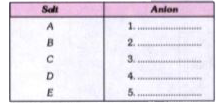A student studies the properties of Acetic Acid in his school laboratory. Write two observations of the reaction that occurs when he adds a pinch of sodium bicarbonate powder to 5 ml acetic taken in a test tube.
Two observations are :
(i) A gas with brisk effervescence is evolved,
(ii) Lime water turns milky when this gas is passed through it.
Similar Questions
Write your observations for the chemical reactions and name the product formed :
When dilute acetic acid is poured on baking soda.
View SolutionList two observations which you make when you add a pinch of soodium hydrogen carbonate to acetic acid in a test tube. Write the chemical equation for the reaction that occurs.
View SolutionIn a school laboratory the students are studing the properties of ethanoic acid through certain experiments. How can they test its acidic nature ? Give two tests .
View SolutionSalts A, B, C, D and E undergo reactions (i) to (v) respectively. Identify the anion present in these salts on the basis of these reactions. Tabulate your answers in the format given below:
(i) When silver nitrate solution is added to a solution of A, a white precipitate, insoluble in dilute nitric acid, is formed.
(ii) Addition of dilute hydrochloric acid to B produces a gas which turns lead acetate paper black.
(iii) When a freshly prepared solution of ferrous sulphate is added to a solution of C and concentrated sulphuric acid is gently poured from the side of the test-tube, a brown ring is formed.
(iv) When dilute sulphuric acid is added to D a gas is produced which turns acidified potassium dichromate solution from orange to green.
(v) Addition of dilute hydrochloric acid to E produces an effervescence. The gas produced turns lime water milky but does not affect acidified potassium dichromate solution.

View SolutionIn a reaction, 5.3 g of sodium carbonate reacted with 6 g of acetic acid. The products were 2.2 g of carbon dioxide, 0.9 g water and 8.2 g of sodium acetate. Show that these observations are in agreement with the law of conservation of mass.
sodium carbonate + acetic acid → sodium acetate + carbon dioxide + water
View Solution(a) Write the name and symbol of group 17 element belonging to second period.
(b) Write electronic configuration of K(19) . To which group of periodic table does it belongs ?
(c) What are substitution reactions ? Give one example
(d) What happens when acetic acid reacts with sodium bicarbonate ? Give the chemical reaction involved.
(e) Why does carbon from covalent bonds ?
View SolutionA student adds a spoon full of powered sodium hydrogen carbonate to a flask containing ethanoic acid. List two main observations, he must note in his note book, about the reaction that takes place. Also write chemical equation for the reaction.
View Solution2 mL of sodium hydroxide solution is added to a few pieces of granulated zinc metal taken in a test tube. When the contents are warmed, a gas evolves which is bubbled through a soap solution before testing. Write the equation of the chemical reaction involved and the test to detect the gas. Name the gas which will be evolved when the same metal reacts with dilulte solution of strong acid.
View SolutionRead the given passage and answer the questions number 1 to 5 that follow:
The substitution reaction of alkyl halide mainly occurs by SN1 and SN2 mechanism. Whatever mechanism alkyl halides follow for the substitution reaction to occur, the polarity of the carbon halogen bond is responsible for these substitution reactions. The rate of SN1 reactions are governed by the stability of carbocation whereas for SN2 reactions steric factor is the deciding factor. If the starting material is a chiral compound, we may end up with an inverted product or racemic mixture depending upon the type of mechanism followed by alkyl halide. Cleavage of ethers with HI also governed by steric factor and stability of carbocation, which indicates that in organic chemistry, these two major factors help us in deciding the kind of product formed
1. Predict the stereochemistry of the product formed if an optically active alkyl halide undergoes substitution reaction by SN1 mechanism.
2. Name the instrument used for measuring the angle by which the plane polarised light is rotated.
3. Predict the major product formed when 2-Bromopentane reacts with alcoholic KOH.
4. Give one use of CHI3
5. Write the structures of the products formed when anisole is treated with HI.
View SolutionIf two ml of dil. Acetic acid is added to a test tube containing powdered sodium bicarbonate, What will you observe ?
View Solution
